Photos of the DH Boat - 5
The DH Boat is a plywood construction.
It was a design project by a friend of mine, to see how big a boat he could build out of 2 sheets of 4 ft. x 8 ft. plywood.
The prototype boat is over 10 years old.
Details - Oars
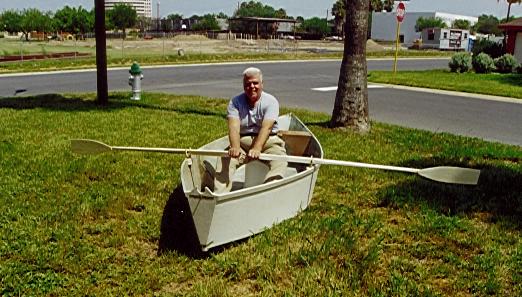 D.H. in rowing position, perhaps sitting a little high, on a plastic bucket seat.
Use a cushion for long distance rowing.
The passenger, if any, should sit on the bottom, giving the rig more stability.
D.H. in rowing position, perhaps sitting a little high, on a plastic bucket seat.
Use a cushion for long distance rowing.
The passenger, if any, should sit on the bottom, giving the rig more stability.
 Home made oars can be a thing of beauty.
These started out as two square sectioned pieces cut out of a 2x4 then
shaped and had the blades (pieces of plywood) attached at the ends.
The oarlocks were purchased, and are pinned to the oars.
It is easier to row with the oarlocks pinned to the oars, but not as efficient
because you can not feather (twist the oar horizontle) when doing the back stroke
while rowing. For beginners pin oars are MUCH better. (my opinion)
Home made oars can be a thing of beauty.
These started out as two square sectioned pieces cut out of a 2x4 then
shaped and had the blades (pieces of plywood) attached at the ends.
The oarlocks were purchased, and are pinned to the oars.
It is easier to row with the oarlocks pinned to the oars, but not as efficient
because you can not feather (twist the oar horizontle) when doing the back stroke
while rowing. For beginners pin oars are MUCH better. (my opinion)
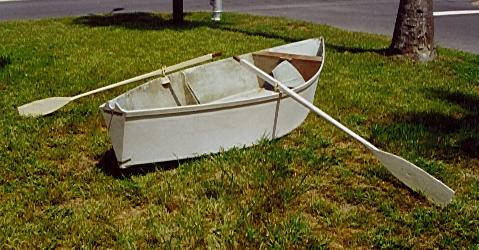 Oars mounted in regular fashion.
Note that the plywood blade is mounted on the aft side of the oar.
It would work the other way, but it works better this way.
Oars mounted in regular fashion.
Note that the plywood blade is mounted on the aft side of the oar.
It would work the other way, but it works better this way.
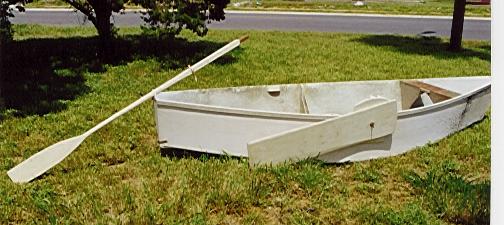 This photo reveals why the notch was put in the top of the transom.
One can move a boat with a single oar over the stern.
This is called sculling. These oars are not well suited for sculling.
An oar used for sculling should be smooth on both sides.
One twists the oar blade while moving it side to side when sculling.
There is more to it than that, but that is a subject better delt with another time.
This photo reveals why the notch was put in the top of the transom.
One can move a boat with a single oar over the stern.
This is called sculling. These oars are not well suited for sculling.
An oar used for sculling should be smooth on both sides.
One twists the oar blade while moving it side to side when sculling.
There is more to it than that, but that is a subject better delt with another time.
An oar over the stern can also work to steer the boat if you do not have a rudder or
if the rudder is damaged or lost. It takes more muscle to steer with an oar than
with a rudder. The mechanical advantage of the rudder makes it easier to use.
However when steering with an oar one can actually row the stern around and achieve
a very fast turn.
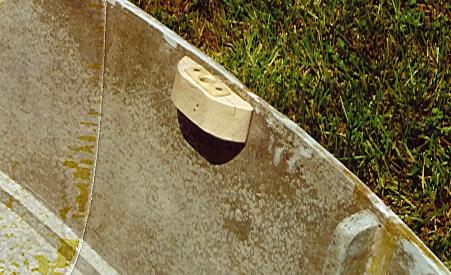 The oarlock's lower spike goes into a rowlock.
These rowlocks were purchased with the oarlocks and fit together well (as they should.)
They were the type to be mounted down in a deck. As there is no deck a wooden block was
constructed, a hole to accept the rowlock was made and the whole assembly was screwed on
to the side of the hull. There are other styles of rowlocks that screw or bolt directly to
the side of the hull. They would have been easier to mount, but none were available when
we built this boat, so we made do as you see here.
The oarlock's lower spike goes into a rowlock.
These rowlocks were purchased with the oarlocks and fit together well (as they should.)
They were the type to be mounted down in a deck. As there is no deck a wooden block was
constructed, a hole to accept the rowlock was made and the whole assembly was screwed on
to the side of the hull. There are other styles of rowlocks that screw or bolt directly to
the side of the hull. They would have been easier to mount, but none were available when
we built this boat, so we made do as you see here.
One can mount thole pins instead of using oarlocks and rowlocks and row like the Vikings
did, or you can use a single thole pin and a loop of rope to keep the oar attached during
the backstroke, or you can use a single thole pin and put a block on the oar with a hole
in it for the thole pin to go through like Portugese fishermen in Nazare.
As in much of boating there is much room for variation. All the variations work, but
some are better in some situations than others.
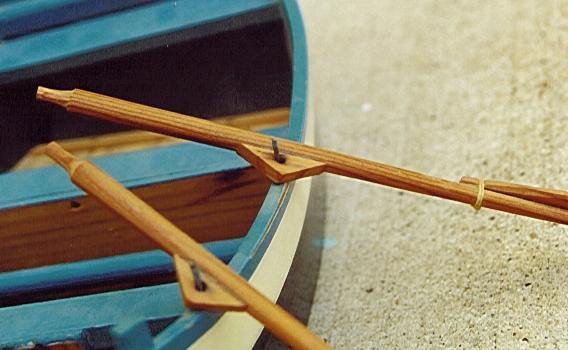
Detail of oars on Nazare fishing boat.
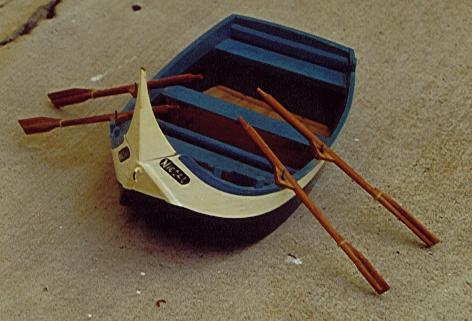
Model of a traditional fishing boat from Nazare, Portugal.
It is rumored that these have traits of ancient Phonecian boats.
A Thole pin is a dowel of hard wood or metal sticking up from the side of a boat. If there are
2 thole pins the oars are placed between them to row.
If there is a single thole pin the oars are plaed aft of the pin and some form of attachment
such as a rope gromet or block attached to the oar with a hole for the thole pin is used
to keep the oar from pulling away from it during the backstroke.
Click here to return to the whole hull pictures (DHBoatP1.htm).
Click here to return to the Hull Detail pictures (DHBoatP2.htm).
Click here to the Detail pictures - Leeboard - (DHBoatP3.htm).
Click here to the Detail pictures - Rudder - (DHBoatP4.htm).
Click here to the Detail pictures - Oars - this page - (DHBoatP5.htm).
Click here to return to the page with the Diagrams (DHBoatp1.htm).
====
Return to the boat building index page.
If you mail me about this page refer to page dhboatp5.htm
 Home made oars can be a thing of beauty.
These started out as two square sectioned pieces cut out of a 2x4 then
shaped and had the blades (pieces of plywood) attached at the ends.
The oarlocks were purchased, and are pinned to the oars.
It is easier to row with the oarlocks pinned to the oars, but not as efficient
because you can not feather (twist the oar horizontle) when doing the back stroke
while rowing. For beginners pin oars are MUCH better. (my opinion)
Home made oars can be a thing of beauty.
These started out as two square sectioned pieces cut out of a 2x4 then
shaped and had the blades (pieces of plywood) attached at the ends.
The oarlocks were purchased, and are pinned to the oars.
It is easier to row with the oarlocks pinned to the oars, but not as efficient
because you can not feather (twist the oar horizontle) when doing the back stroke
while rowing. For beginners pin oars are MUCH better. (my opinion)
 D.H. in rowing position, perhaps sitting a little high, on a plastic bucket seat.
Use a cushion for long distance rowing.
The passenger, if any, should sit on the bottom, giving the rig more stability.
D.H. in rowing position, perhaps sitting a little high, on a plastic bucket seat.
Use a cushion for long distance rowing.
The passenger, if any, should sit on the bottom, giving the rig more stability.
 Oars mounted in regular fashion.
Note that the plywood blade is mounted on the aft side of the oar.
It would work the other way, but it works better this way.
Oars mounted in regular fashion.
Note that the plywood blade is mounted on the aft side of the oar.
It would work the other way, but it works better this way.
 This photo reveals why the notch was put in the top of the transom.
One can move a boat with a single oar over the stern.
This is called sculling. These oars are not well suited for sculling.
An oar used for sculling should be smooth on both sides.
One twists the oar blade while moving it side to side when sculling.
There is more to it than that, but that is a subject better delt with another time.
This photo reveals why the notch was put in the top of the transom.
One can move a boat with a single oar over the stern.
This is called sculling. These oars are not well suited for sculling.
An oar used for sculling should be smooth on both sides.
One twists the oar blade while moving it side to side when sculling.
There is more to it than that, but that is a subject better delt with another time. The oarlock's lower spike goes into a rowlock.
These rowlocks were purchased with the oarlocks and fit together well (as they should.)
They were the type to be mounted down in a deck. As there is no deck a wooden block was
constructed, a hole to accept the rowlock was made and the whole assembly was screwed on
to the side of the hull. There are other styles of rowlocks that screw or bolt directly to
the side of the hull. They would have been easier to mount, but none were available when
we built this boat, so we made do as you see here.
The oarlock's lower spike goes into a rowlock.
These rowlocks were purchased with the oarlocks and fit together well (as they should.)
They were the type to be mounted down in a deck. As there is no deck a wooden block was
constructed, a hole to accept the rowlock was made and the whole assembly was screwed on
to the side of the hull. There are other styles of rowlocks that screw or bolt directly to
the side of the hull. They would have been easier to mount, but none were available when
we built this boat, so we made do as you see here. 
